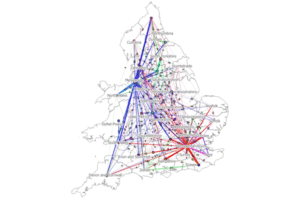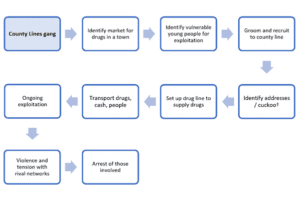
County Lines & Cuckooing: What Housing Providers need to know
July 2022
Jo Sylvester
About the Author:
Jo Sylvester is a Community Resolution Officer and the Safeguarding Operational Lead for Ongo Homes. Jo created the Cuckooing Project in April 2019 for which she won Resolve ASB’s Award for Best Project in 2021.
Introduction
We often hear phrases like “county lines”, “OCG” and “cuckooing” mentioned in the media or on TV, but do we actually know what they mean or how they present in daily life?
The aim of this briefing is to shine a light on these criminal practices, so as housing providers we can fully understand the impact and consequences this behaviour has on victims – our tenants.
What is a County Line?
The UK Government describes a County Line as:
‘A term used to describe gangs and organised criminal networks involved in exporting illegal drugs into one or more importing areas within the UK, using dedicated mobile phone lines or other forms of “deal line”. They are likely to exploit children and vulnerable adults to move and store the drugs and money, and they will often use coercion, intimidation, violence (including sexual violence) and weapons.’ (www.gov.uk)
As a hypothetical example, imagine an invisible line that starts from London where the supply of drugs originates, and ends in Sheffield where the drugs will be delivered. In practical terms, drugs will be loaded in to a car/van and it will be the responsibility of one member of an OCG (organised crime group) to deliver that shipment. Since the drugs are being taken over the county borders, this invisible line is then referred to as a “County Line”.
This County Line will be given a nickname, for example “fire”/“red”/“jazz”, so when we are in conversation with our tenants who are drug users, they may refer to “I got my drugs from Jazz”, which sounds like a person but is actually the nickname for the County Lines ‘deal line’ phone contact.
The below graphic from www.gov.uk shows how the county lines in operate.

What is an OCG?
An Organised Crime Group is the collective name for a group of individuals whose main purpose is serious organised crime, which can include drug dealing, financial crime, human trafficking and other types of exploitation. A County Line often forms part of that group’s criminal activity.
The group structure is similar to that of a pyramid scheme.

The top layer are the main players – the individuals who are running the group. They are not going to draw attention to themselves by buying fancy cars/big houses etc. or by being involved in the drug dealing activity, therefore making it harder for the police to investigate them.
The second layer are the generals. They call the day-to-day shots. They give the orders and expect the others to deliver, otherwise there will be consequences – which could include physical violence such as machete attacks.
The third layer are your dealers. They will be the ones that everyone has heard of and are often sporting designer clothing and jewellery. We had one OCG kit their dealers in a branded designer tracksuit showing they belonged to his group. What he didn’t realise was this made it much easier to spot them and report the information through to the police as intelligence!
The bottom layer are the runners. These are recruited by the dealers to do the ‘running about’. Dealers will use exploitation and grooming tactics to recruit young people and vulnerable adults. The desirable characteristics of a runner are:
- Young people lacking a support network
- Young people truanting/disengaging from services
- Victims of violent offending
- In financial difficulty – may already be in debt to the county line already
- Have mental health conditions
- Have drug/alcohol addictions
An OCG does not differentiate between children or adults, they just see a way to increase their profits/income whilst distancing themselves from the criminal activity.
Runners are often recognised as young men with cross-body bags on bikes quickly moving around our estates. Nipping in and out of communal blocks, standing on corners and doing quick exchanges. They are under a lot of pressure to deal the drugs and are told how much they are expected to earn. If they falter in obtaining this target amount there will be a threat of violence to them and possibly their families.
Case Example – Alex
Alex is under 18 years old and used to get out of the house and hang around outside the local shops. He would sometimes chat with his mates about not having any money when one day an older man approached him and said that he was happy to lend him £20 so he could buy something from the shop. Alex thought that this was great and the man didn’t make a big deal about having it paid back straight away, so he took the money and spent it. A few weeks later the man approached Alex and asked him to repay the £20 owed by doing him a small favour. Alex was to deliver a parcel to a particular car which would pull up in the next 30 minutes. Alex agreed as he thought this was easy enough and when the car pulled up, he gave them the parcel. The next day the man turned up and said that he wanted some more errands doing and he would give him some money for it. Alex agreed as it was easy money. However, the next time Alex saw this guy, he made it clear that Alex now worked for him and that if he didn’t do as he was told, he would go and stab his family. He knew where his family lived and who is mum and sister were. Alex, through fear of violence, started to work for the man. He cemented this relationship with extra cash so Alex could go buy himself some new trainers/clothes/jewellery but at the same time inflict fear of violence towards him and his family.
Below is an infographic taken from www.gov.uk which demonstrates the cycle of Organised Crime:

What is Cuckooing?
Wildlife experts say that cuckoo birds raid other nests to try to replace the eggs with their own. The female bird whose nest it is will sit on the eggs until they are ready to hatch. Upon hatching, the baby cuckoos will force out the other baby species of birds in the nest to ensure their own survival.


The criminal law definition is a form of crime in which drug dealers take over the home of a vulnerable person in order to use it as a base for drug dealing.
Put both of these definitions into daily life and we have vulnerable tenants who are threatened and exploited to allow drug dealers to use or take over their home for the purpose of selling drugs.
However, I have been able to identify that it is not just drug dealers who carry out this cuckooing behaviour. It can also happen with tenants who are lonely and kind, who get taken advantage of by street workers and even family or friends.
Case Example – Dennis – Street workers
Dennis lived in a one-bedroom flat within a high-rise block. With his property being close to the town centre, he met a street worker who “befriended” him. But the relationship escalated into her visiting on and off before suddenly moving her belongings into the property.
Soon after, she started using the property for her business – but would also regularly have friends round using drugs. Anti-Social Behaviour complaints were made as the noise of the visitors coming and going, shouting up at the windows to be let in were badly affecting the other residents.
Suddenly a man turned up at the property and started to treat Dennis’s flat as his own, living in andsupplying the drugs to the street worker and her friends.
Dennis quickly fled the property, leaving the street worker to have full control. Luckily he contacted Ongo’s offices to say that he was frightened to return and that he had fled due to the situation getting out of control. With the support of our local Neighbourhood Policing Team, we visited the property, changed the locks and escorted all individuals from the property out. Dennis was able to return to his property and receive additional support from us to ensure that he was not bothered again.
Case Example – Colin – family/friends
We were contacted by the mother and sister of our tenant Colin, as they were concerned about the people who had moved in to Colin’s property.
Colin had spoken to them on the phone and had said that he was frightened by the people in his home and he didn’t know what to do about it. His mum and sister had tried to visit him but had been refused entry into the property and they were concerned for his welfare.
I arranged to meet with them and Colin away from the property at a location where he felt safe. Colin chose a local café where he often went so that it did not raise suspicion, in case he was followed or questioned about it later.
At the meeting, Colin informed me that a family had moved into his property with two small children and that he was being forced to live in his bedroom. They had now put a lock on the door, and were taking all of his money and food. I asked how he knew the family and he said that he had known them for a long time, and had been contacted by them following their recent eviction from another town and had nowhere to live. He was living in a three-bedroom property on his own so he offered for them to stay with him until they got back on their feet. However, they soon took over and the breaking point was that they had burnt all of his furniture in the garden and destroyed his belongings.
We discussed the property size and to the option of downsizing to a one-bedroom property. Colin agreed with this as he was struggling to keep on top of his rent. He said that the man of the family had threatened to beat him if he spoke to anyone about the situation and therefore was worried about speaking to me, without them knowing. I suggested that I would send him an appointment letter to visit him at the property to discuss his tenancy and our offer of support in moving him. This way if the family happened to intercept his post and read it, they would be aware of the purpose of the visit and may get them thinking about their own situation. He would just have to pretend that this appointment had come out of the blue.
I attended the property on the day of the appointment and the family introduced themselves to me as it being their property. I unfortunately had to inform them that it wasn’t their property as the tenancy was in Colin’s name and that they would not be entitled to a voluntary assignment since they owed us rent arrears from when they last held a tenancy with us. I then spoke with Colin about supporting him to downsize to another property which he gratefully accepted.
I notified the family that they would have to leave the property and I supported them in contacting the local Housing Advice Team.
Colin is still in his new property and has not had any further issues since.
As you can see in both of the above examples, the victims were not drug users, but had been exploited because they were lonely and kindhearted. Unfortunately they are not the only ones.
Since the start of the Cuckooing Project in 2019, we have received the following referrals:
- 1st April 2019 – 31st March 2020 = 44 referrals (17 – Drug related, 17 – Street Worker, 10 – Friends/Associates)
- 1st April 2020 – 31st March 2021 = 34 referrals (18 – Drug related, 9 – Street Worker, 7 – Friends/Associates)
- 1st April 2021 – 31st March 2022 = 40 (21 – Drug related, 8 – Street Worker, 11 – Friends/Associates)
Who is a risk of being cuckooed?
Since cuckooing is an exploitation behaviour, it is often individuals with vulnerabilities that are targeted. This can also include individuals who are lonely or are empathetic to a situation as demonstrated above in the case examples. However, there are also other groups who could be at risk:
- Drug users – drug dealers are only likely to target those who are already known to them through the buying/selling of drugs.
- Single men over the age of 50 – this has been determined through the referrals received involving street workers.
- Individuals with mental health illnesses, learning disabilities or physical health problems.
- Those living in poverty or with limited finances.
In my experience, the victims of cuckooing often live alone, in a one or two-bedroom property. It is never families that are targeted. When it comes to looking at proactive work in our areas and highlighting to residents the concerns around cuckooing, being able to target specific demographics enables us to focus the resources to the correct locality.
Case Example –Eddie
I learnt about Eddie following a drugs warrant that had been executed by our local police force. I had gone to serve the tenant with a Notice Seeking Possession, but on visiting his property, Eddie informed me of an incident that had left him compromised.
A friend of his had gone round for a cup of tea and a catch up as they had not seen each other for quite some time. Eddie was a drug user but was on a methadone programme with the local substance abuse support service. Whilst his friend was visiting, he unexpectedly invited one of his own friends round. A man arrived at the property who Eddie knew to be a local drug dealer. He offered him a cup of tea and they were talking when all of a sudden the drug dealer reached inside his jacket pocket and threw a package at Eddie and told him “that is £500 worth of crack which you now have to sell for me”.
The dealer got up to leave and his parting comments were “and if you don’t you’ll get stabbed”. Eddie was instantly frightened. He knew this dealer had a reputation for extreme violence, so felt that he had to comply. He felt obliged to have people visiting his property to buydrugs. And they just kept coming. The dealer kept going back with more for him to sell, each time with a threat of violence.
I asked Eddie whether he wanted to remain in his property, and if so, what support could be offered for him to feel safe in his home. He wanted to stay, so I provided him with a large tub of paint to help with redecorating, CCTV cameras to put in his windows and large signs that said that ONGO had provided CCTV and were monitoring the address. This was Eddie’s idea to discourage anyone coming back to his property again if they knew the landlord was monitoring.
It worked! Eddie cleaned and redecorated the property and has had no further contact with the drug dealers. He has managed to work extremely hard to reduce his drug dependency and improve his overall health, too.
It is a difficult situation for drug users, as often they will be lured into “free drugs” for use of a property, and then the next minute they are being raided by the police as the situation escalates out of their control.
What are the signs?
Below is a guide to assist professionals in how to spot the signs of cuckooing:
- Increase in visitors or calls to a property
- New people at a property or location
- Regularly changing residents at a property
- Changes in the mood of a resident at a property – secretive / withdrawn / aggressive / paranoid / emotional
- Evidence of substance use/paraphernalia (unless this is normal behaviour)
- Changes in a person’s appearance / clothing style – positive and negative
- Unexplained and unaffordable items appearing
- Residents or people you know going missing for long periods of time
- Young / vulnerable persons seen in different vehicles / taxis
- Persons in your community appearing unfamiliar with the surroundings
- Truancy / exclusion / disengaging from services such as schooling, local clubs, social care workers
- Increased anti-social behaviour in the area
- Unexplained injuries or accounts of how injury resulted not seeming plausible
What can housing providers do?
First of all, we need to acknowledge that cuckooing is a tool used by OCGs as a means of increasing their profits regardless of the impact on their victims. As housing providers, we need to play our part in the disruption of this criminal activity. Partnership working is key – especially with our local police forces, and not only with our local neighbourhood policing teams but also with Serious Organised Crime Units.
I attend the Silver and Bronze partnership meetings held by our local police force where strategy and information sharing is key. Housing providers have underutilised tools at our disposal that hold a lot of potential for working alongside the police
We can also use our tenancy agreement conditions to carry out property inspections, where safe to do so, to speak with potential victims of cuckooing. We can carry out high visibility work in the community, or door knocking exercises, as a means of gathering information from residents. If whilst we are doing this work we are wearing uniform or branded clothing, it puts potential dealers and users off. We can raise awareness in the recognised demographic areas – do neighbours and local residents know what the signs are if a property is being cuckooed? We need to get better at communicating this.
In respect of street workers, we have utilised the use of the CPW (community protection warnings) and CPN (community protection notices) to prevent individuals from attending certain areas and properties.
Most importantly, housing providers must recognise that cuckooing is a safeguarding concern.Individuals are being exploited and cases should be reported to the police immediately. If something doesn’t feel right, it usually isn’t. Where victims have learning disabilities, Adult Safeguarding Referrals should also be submitted.
Unfortunately, there have also been occasions where we have supported victims of cuckooing only for them to be back in the same situation a year or two later. Therefore consideration should be given as to whether the individual has the capacity to manage their own risks.
We need to try to sustain tenancies. Our main aim is to PROTECT vulnerable people and offer SUPPORT and cause as much DISRUPTION to the Criminal Groups as possible.
Jo Sylvester
Community Resolution Officer, Safeguarding Lead at Ongo
For further information contact Jo at: [email protected]






Thanks to Jo at Ongo for this great briefing note. If you are interested to hear more about Jo’s approach do join us at the upcoming event she’ll be speaking at on supporting people living in supported housing – https://app6148.cloudwayssites.com/events/supporting-residents-in-supported-housing-how-to-get-on-top-of-a-growing-crisis/